Tavče Gravče (Macedonian Baked Beans)

What is Tavče Gravče?
Tavče Gravče (pronounced TAV-cheh GRAV-cheh) is a traditional Macedonian dish made with baked beans. Often referred to as the national dish of North Macedonia, it’s hearty, flavorful and traditionally vegan (though variations can also include meat). The beans are typically slow-cooked and seasoned with a blend of spices and aromatics like paprika and garlic, then baked until they develop a rich, savory taste. Served in a clay pot, Tavče Gravče is a comfort food staple enjoyed throughout the Balkans.
The roots of Tavče Gravče stretch back centuries, deeply entwined with the culinary traditions of the Balkans. Beans were a staple crop in Macedonia, and over time, the method of slow-cooking them with spices evolved into what we know today as Tavče Gravče. Since a large part of the population of North Macedonia is Orthodox Christian, the dish is often enjoyed on a Friday, when fasting rules restrict the use of most animal products.

Ingredients You’ll Need & How to Substitute
To make Tavče Gravče, you’ll need the following ingredients:
- White kidney beans: Traditionally a special variety from Tetovo is used, but cannellini beans or even butter beans work well too. Essentially, you can follow the same method using any bean, but you’ll need to adjust the cooking time. If in a hurry, you can also use jarred or canned beans, although this dish gets its rich flavour from simmering the beans with the aromatics.
- Onion and garlic: For a flavor-packed base.
- Paprika: To add warmth and color. If you’d like a smoky flavor, substitute 1 teaspoon of the paprika with smoked paprika.
- Dried chillies (optional): For a little bit of heat. You can also add some chilli powder.
- Bay leaves: For aromatic depth. Simply leave this out if you can’t get them.
- Tomato paste: Enhances the tangy flavor and red color.
- Sliced red peppers and onions: for a great addition to the beans. You can use differently colored peppers, bell peppers or even tomatoes.
Pressure Cooker
Using a pressure cooker is a great way to cook legumes from scratch in a matter of minutes. They will be much more tender compared to being cooked in an ordinary pan and take a fraction of the time and energy, sometimes speeding up the process by 90%. Since pressure cookers vary slightly from manufacturer to manufacturer, please refer to the manual for how to use the one you own. Personally, I recommend the Fissler Vitavit Premium 3.5l (or larger).
It takes about 10 minutes to come to a boil and reach the full pressure and a further 8 minutes until the beans are perfectly cooked. So after just 18 minutes your beans are ready and you can release the pressure. If you do use a pressure cooker for this recipe, you can deduct 1 hour and 20 minutes of the total cooking time.
Tips:
- Adding 1 tablespoon of vegetable or olive oil to the water helps to reduce foaming in your pressure cooker while cooking legumes.
- To save even more energy, you can also cook the beans for only 5 minutes and let the cooker cool off entirely before opening it, thereby allowing it to slowly release the pressure by itself. This usually takes around 30 minutes.
How to make Tavče Gravče (step-by-step)
Soak the beans. Soak the beans with 1 tablespoon (14g) of salt in at least 1.5l of water overnight. If using a pressure cooker, you don’t need to add the salt.
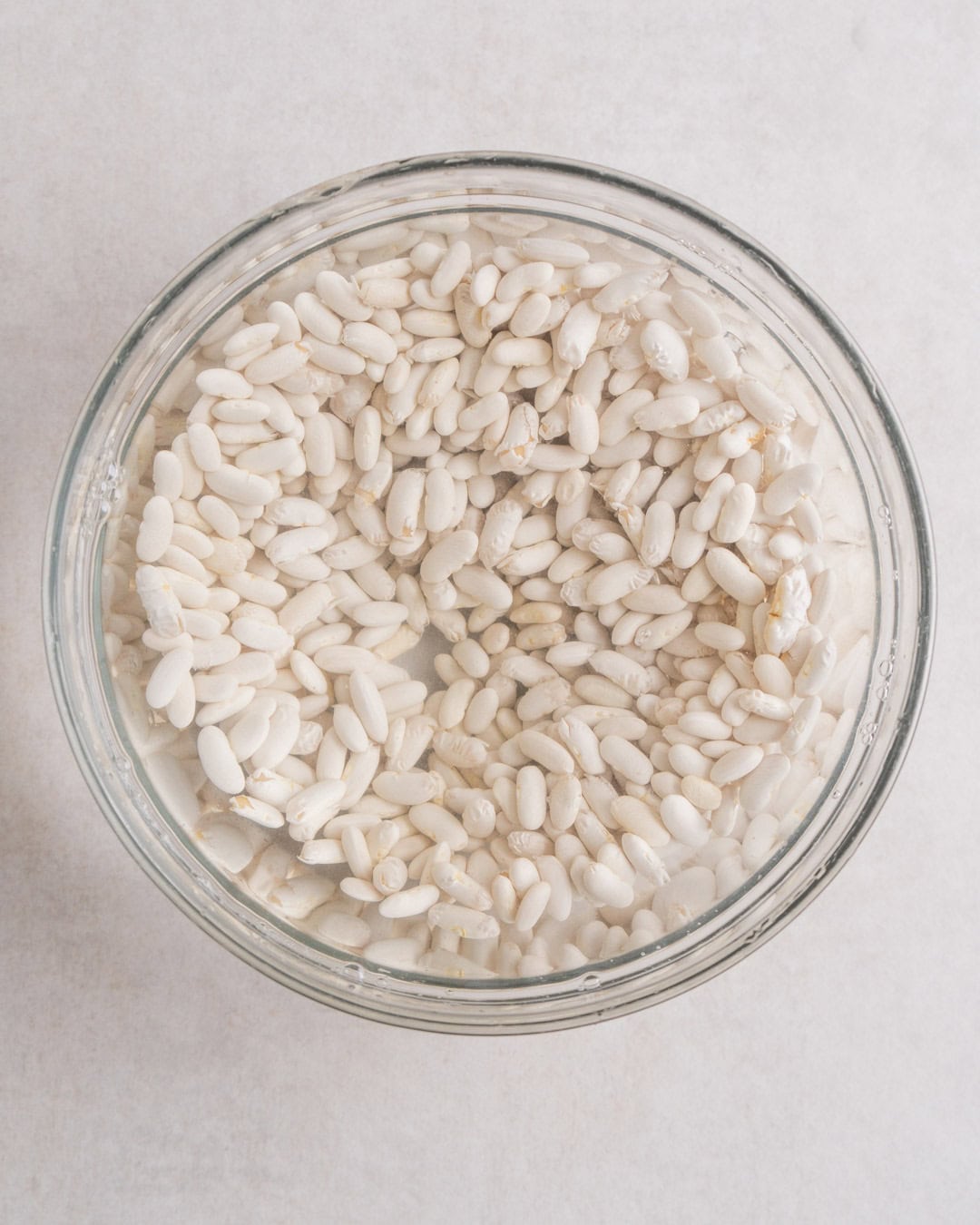
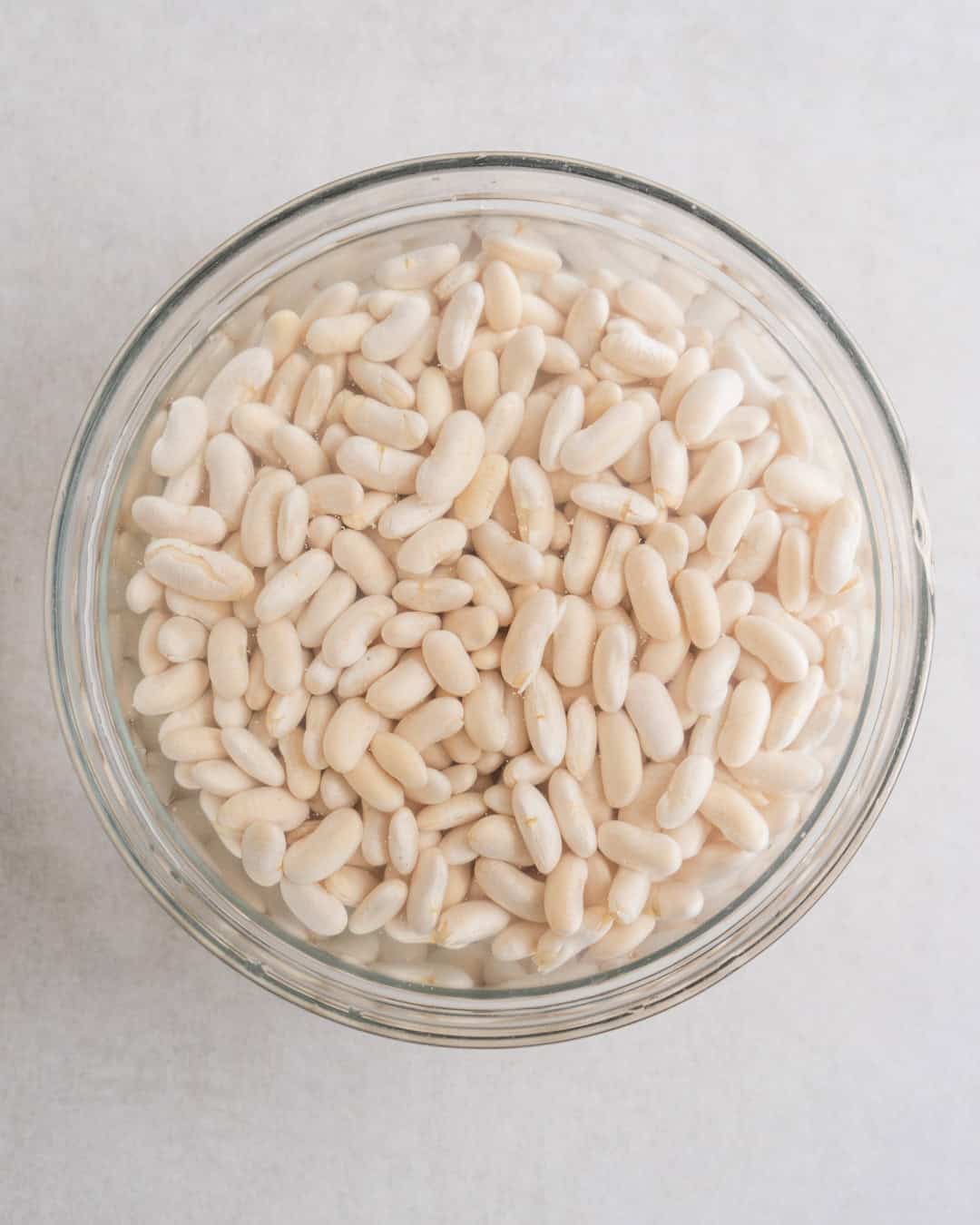
Cook the beans. The next day, drain and rinse the beans and add them to a large saucepan with 2 litres of water. Peel one of the onions, cut it in half widthways (through the equator) and add one half to the beans, reserving the other half as a garnish later on. Peel 4 of the garlic cloves and add them to the beans together with the bay leaves and dried chillis. Bring to a boil, skim off any froth, then reduce the heat and simmer with a lid left slightly ajar for 1 hour and 30 minutes or until tender. Alternatively, cook for 8 minutes with 1l of water in a pressure cooker. Set aside the chillies, bay leaves and, separately, the onion and garlic, then drain the beans but keep the cooking liquid. Meanwhile slice the set aside raw onion half into thick rings, slice the red peppers and set both aside for later.
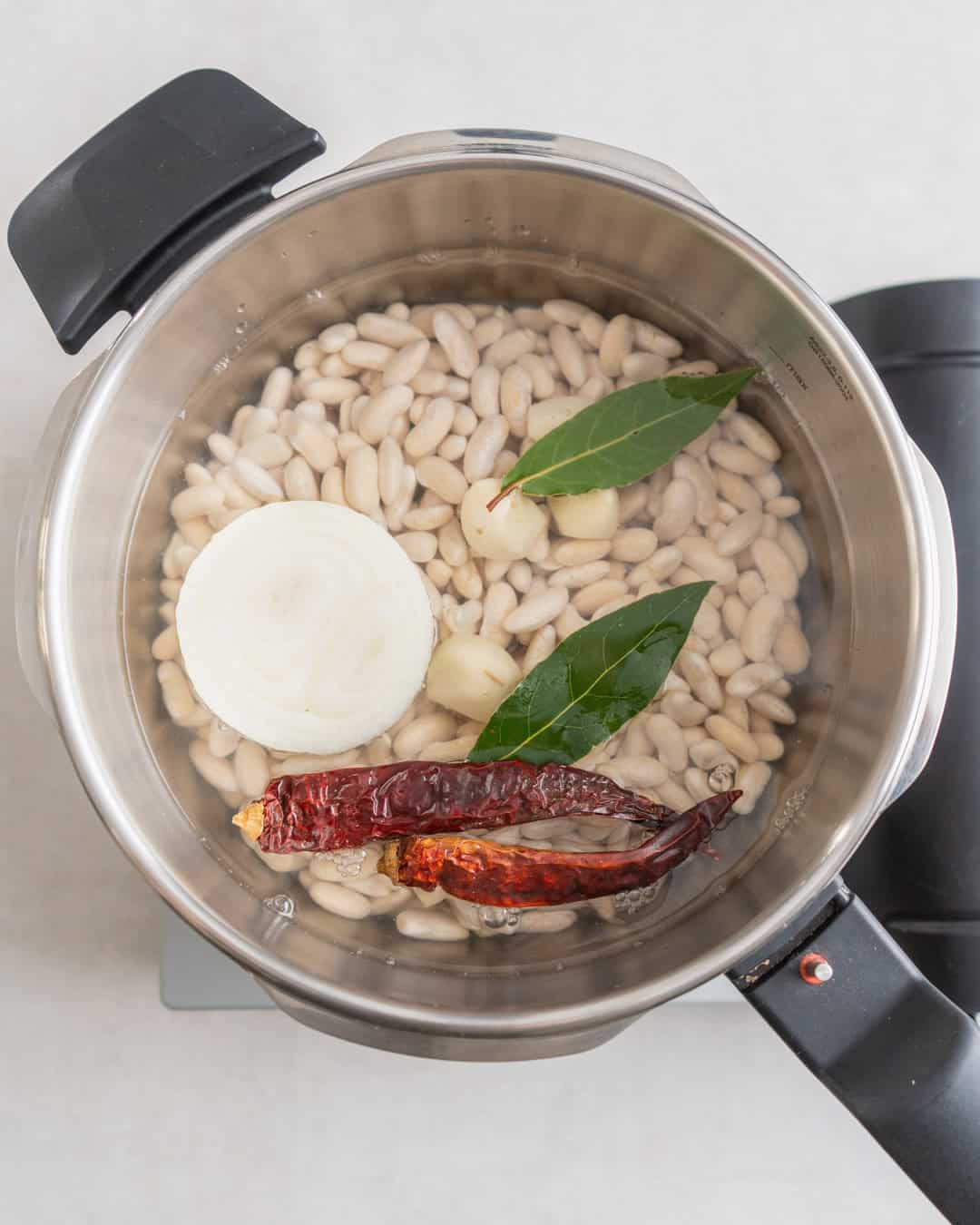
Make the roux. When the beans have around 10 minutes left, pre-heat the oven to 200°C (180°C fan). Heat the oil over medium-low heat in a frying pan. Peel and finely chop the remaining onion and sauté in the oil until translucent (6-8 minutes). Peel and grate or crush in the remaining 3 garlic cloves and continue cooking until aromatic. Stir in the tomato paste, then mix in the flour and paprika, followed by 200ml of the bean cooking liquid to turn it into a sauce. Turn off the heat.
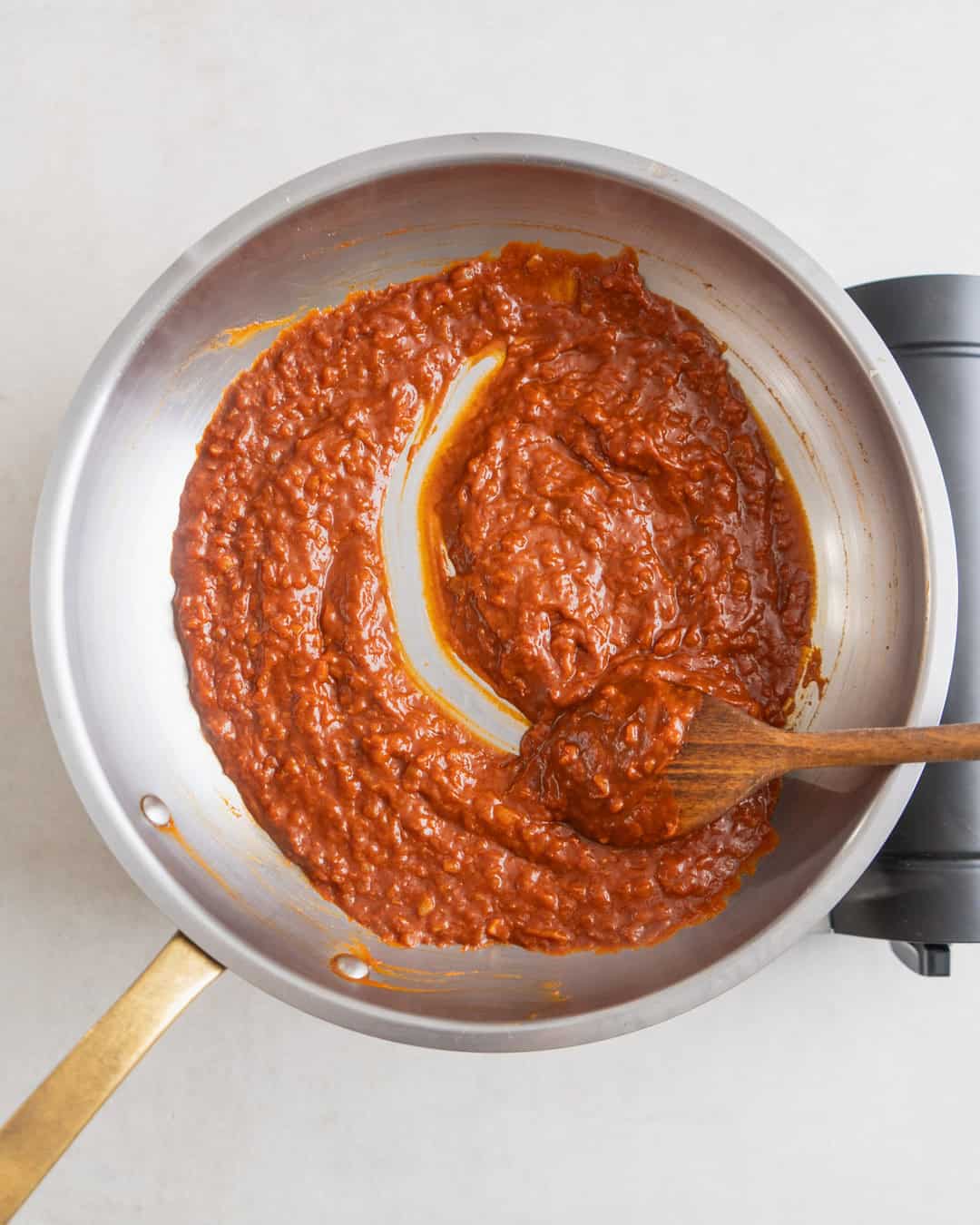
Combine with beans. Transfer the beans to a 28cm-wide terracotta dish or shallow casserole. Use a fork or knife to mash up the cooked onion and garlic that you set aside earlier and add them to the casserole followed by the sauce, pepper, mint, salt and another 200ml of the cooking liquid. Give it a stir. Stir in the red pepper slices, squish in the onion rings and place the chillies and bay leaves inbetween as a garnish. Spoon some of the sauce over the onions to caramelise while roasting, then drizzle everything with a little more oil.

Bake. Bake for 30 minutes until the onions are slightly charred and the beans look gnarly. Remove from the oven and let it rest for 15 minutes, during which it’ll thicken further.
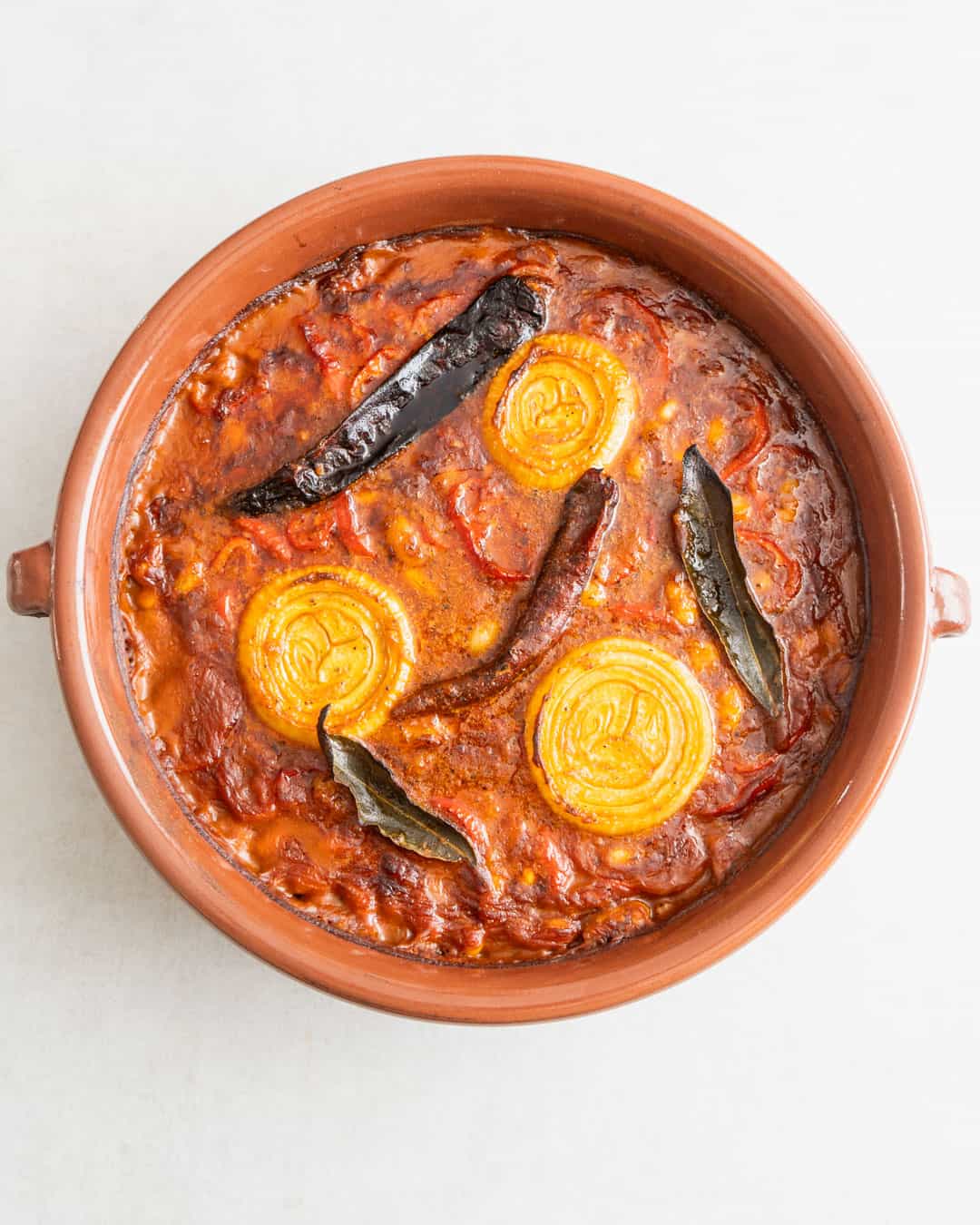
Serve. Discard the bay leaves and chillies and serve with some crusty bread.
Useful Tips
- Don’t skip the soaking: Soaking beans overnight is crucial for even cooking and easier digestion. Adding salt to the soaking water breaks down the skins of the beans and allows them to cook faster and become more tender.
- Use a pressure cooker: save time and energy with this ingenious gadget.
- Adjust the roux: Add more flour if you’d like a thicker sauce. You can also dilute it by adding more water.
- Don’t waste the aromatics: Mashing the cooked aromatics that you used with the beans adds flavour to the sauce and helps to naturally thicken it.
- Use a clay pot: If you have one, baking in a clay pot will give the dish its signature earthy flavor.
- Make ahead: Tavče Gravče also tastes great the next day when the flavors deepened, making it an excellent make-ahead dish.
Why You’ll Love This Tavče Gravče Recipe
- naturally & traditionally vegan
- comfort food
- budget-friendly
- packed with protein
- can be scaled up to feed a crowd
How to Store Tavče Gravče
Store any Tavče Gravče leftovers in an airtight container in the fridge for up to 3-4 days. To reheat, simply warm it on the stove, adding a splash of water if needed to prevent it from drying out. You can also freeze portions in freezer-safe containers for up to 2 months. Just thaw it overnight in the fridge before reheating.
Other Slow-Cooked Legumes Recipes You Might Like
- Kuru Fasulye: Türkiye’s National Dish made with white beans
- Potaje de Garbanzos: Spain’s chickpea, potato & spinach stew
- Lolli con Fave: fava beans with homemade pasta
**I receive a small commission from affiliate links on this page**
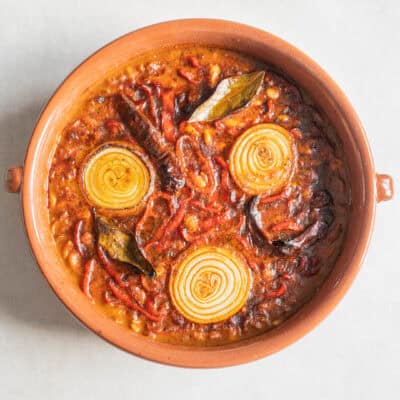
Tavče Gravče (Macedonian Baked Beans)
Equipment
- Pressure Cooker, (I recommend Fissler Vitavit Premium 3.5l or larger), optional
Ingredients
- 320 g dried white kidney beans (like cannellini), or 2 x 570g jars or 3 x 400g cans, see note below
- 2 tbsp salt (28g)
- 2 large onions (400g)
- 7 large garlic cloves
- 2 bay leaves
- 2 long dried chillis
- 2 long red peppers (like Romano, 200g)
- 3 tbsp vegetable oil (or olive oil, plus extra for drizzling)
- 1 tbsp tomato paste (25g)
- 1 heaped tsp plain flour (10g)
- 3 tbsp sweet paprika (25g)
- 1 tsp freshly crushed black pepper
- 1 tsp dried mint
- crusty bread (to serve)
Instructions
- Soak the beans with 1 tablespoon (14g) of the salt in around 1.5l of water overnight. If using a pressure cooker, you don’t need to add the salt.
- The next day, drain and rinse the beans and add them to a large saucepan with 2 litres of water. Peel one of the onions, cut it in half widthways (through the equator) and add one half to the beans, reserving the other half as a garnish later on. Peel 4 of the garlic cloves and add them to the beans together with the bay leaves and dried chillies. Bring to a boil, skim off any froth, then reduce the heat and simmer with a lid left slightly ajar for 1 hour and 30 minutes or until tender. Alternatively, cook for 8 minutes with 1l of water in a pressure cooker (saves 1 hour and 20 minutes of the total cooking time). Set aside the chillies, bay leaves and, separately, the onion and garlic, then drain the beans but keep the cooking liquid.
- Meanwhile slice the set aside raw onion half into thick rings, slice the red peppers and set both aside for later.
- When the beans have around 10 minutes left, pre-heat the oven to 200 °C (392 °F) (180 °C (356 °F)). Heat the oil over medium-low heat in a frying pan. Peel and finely chop the remaining onion and sauté in the oil until translucent (6-8 minutes). Peel and grate or crush in in the remaining 3 garlic cloves and continue cooking until aromatic. Stir in the tomato paste, then mix in the flour and paprika, followed by 200ml of the bean cooking liquid to turn it into a sauce. Turn off the heat.
- Transfer the beans to a 28cm-wide terracotta dish or shallow casserole. Use a fork or knife to mash up the cooked onion and garlic that you set aside earlier and add them to the casserole followed by the sauce, pepper, mint, remaining 1 tablespoon of salt (14g) and another 200ml of the cooking liquid. Give it a stir.
- Stir in the red pepper slices, squish in the onion rings and place the chillies and bay leaves inbetween as a garnish. Spoon some of the sauce over the onions to caramelise while roasting, then drizzle everything with a little more oil and bake for 30 minutes until the onions are slightly charred and the beans look gnarly. Remove from the oven and let it rest for 15 minutes, during which it’ll thicken further. Discard the bay leaves and chillies and serve with some crusty bread.

I’ve been following you on Instagram for a while, and am enjoying learning about new (to me) vegan recipes and your smile always brings out my own. Today, I finally made this dish and it is magnificent! Those few ordinary ingredients came together into a creamy, crunchy, thick and saucy flavor explosion that left my entire being satisfied. I will make more of your recipes in the near (and far) future!
Thanks for the wonderful feedback! That is so nice to hear. I’m glad you liked the recipe! That’s what it’s all about. Good, wholesome, natural food that puts a smile on your face!
As a Macedonian I can only salute you for this recipe. I have tried this/your version of Tavce gravce and it’s very sophisticated dish. Благодарам!
That means a lot. My goal is always to cook these dishes as authentically as possible, so feedback like this is very motivating. Thanks!
Ever since I saw your short for this, I had had this on my list to try and I finally made it this evening. It’s so good! I used to live in Serbia, and there are similar dishes there, both with and without meat. It took me right back to those happy memories! I served this with a tomato salad, green salad and of course some crusty bread, just perfect!
That’s amazing! Love how evocative food is, and that it’s so nostalgic for you! Glad you liked it.
This dish came out a beautiful texture and was rich and comforting. I’ll definitely be making this regularly!
Amazing, I’m glad you liked it!
This looks absolutely delicious, I will be making it this weekend. I do not seem to be able to print up the recipe though, is there a problem with the site?
I’m sorry about that, that’s fixed now. Thanks for pointing it out. That was indeed an error with the site!